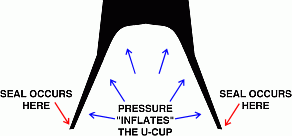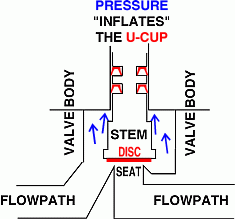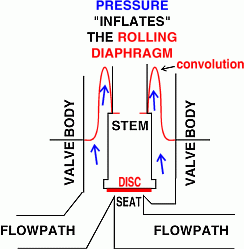Intro to Plastic Valves: SealsO-RingsAn O-ring is a round elastomeric ring. O-rings are ideally suited to be a compressed, static seal between non moving parts. O-rings can be used as a face seal on a valve, and used on rotating shafts. Use of o-rings on linear moving shafts is sometimes not recommended, due to the fact that they create friction, and in extreme cases will rollover, bind, and ultimately cause the valve to stick. U-Cups
A u-cup is an o-ring formed into a u-shaped channel. Liquid or air pressure "inflates" the u-cup and affects a seal. The u-cup is ideal for use on linear moving shafts and piston heads, because unlike an o-ring the shape does not try to roll with the movement and create friction. The sides of the u-cup allow the shaft to move virtually unhindered, and seal with a wiping action. 
If a secondary or even a series of u-cups are used in the design, only the first one is pressurized, so friction is kept to a minimum. Secondary u-cups are used as backup seals in case the first u-cup fails.
Flat DiaphragmsFlat diaphragms are a flat round disc, usually cut from a sheet material, designed to affect a seal when forced against a valve seat. Rolling Diaphragms
This is a diaphragm formed in a convoluted shape. It gets its name because as the stem moves, the diaphragm "rolls" at the convolution. It is frequently used in a manner similar to a u-cup, that is, to seal the gap between a linear moving shaft and the valve body. But unlike the u-cup, the rolling diaphragm is permanently affixed to both the shaft and the valve body. Because it is affixed to the shaft and also "inflates" from fluid pressure, the force of the fluid directly impacts the movement of the shaft. In some cases, such as a relief valve, this force is used to accelerate the movement of the shaft. In a pressure regulator, the force on the rolling diaphragm is what causes the shaft to move, so it is referred to as a "sensing" diaphragm. It is important to eliminate any possibility of water hammer in a piping system where rolling diaphragms are used, as they can be ruptured by the explosive surge.
Sealing DiscsAs shown in the illustration above, a disc is referred to as the elastomeric part affixed to the part of the valve stem that affects a seal against the seat. Discs are frequently flat washer-shaped pieces that are assembled into a retainer; they are also frequently a specially-molded shape that is slipped onto the end of the valve stem. Pressure (usually either spring, air, or line pressure) forces the disc firmly against the orifice seat, affecting a seal. Elastomer Sleeves A pinch valve uses a round rubber tube (sleeve) that is "pinched" to affect a seal. It is pinched either mechanically or with air pressure. Sometimes the sleeve may be formed in a special shape, so that the external force will cause it to fold or collapse at specific points.
--Rick Bolger, Marketing & Advertising Manager, Plast-O-Matic Valves, Inc.
For additional information, please return to the Plast-O-Matic Tech Info Center.  |